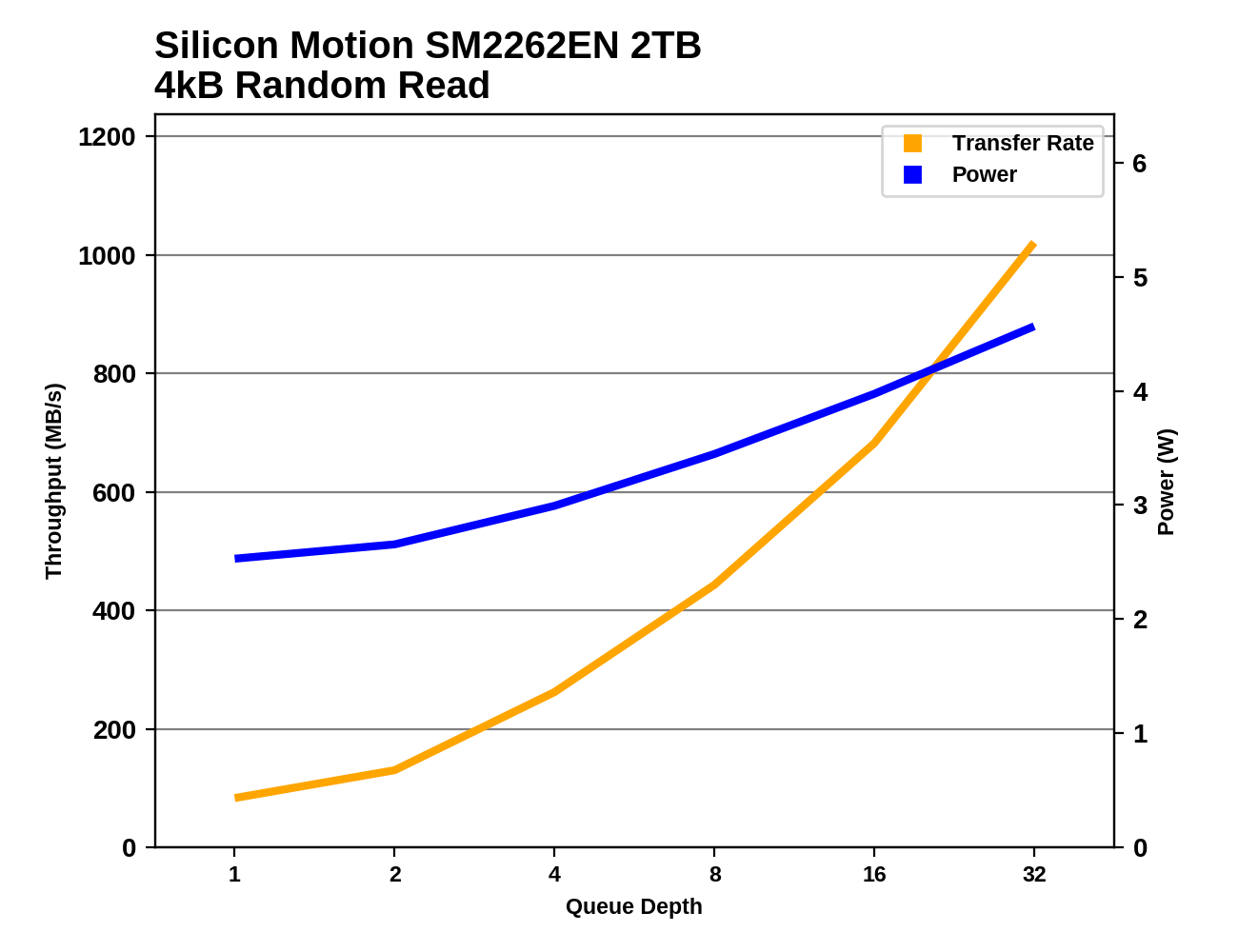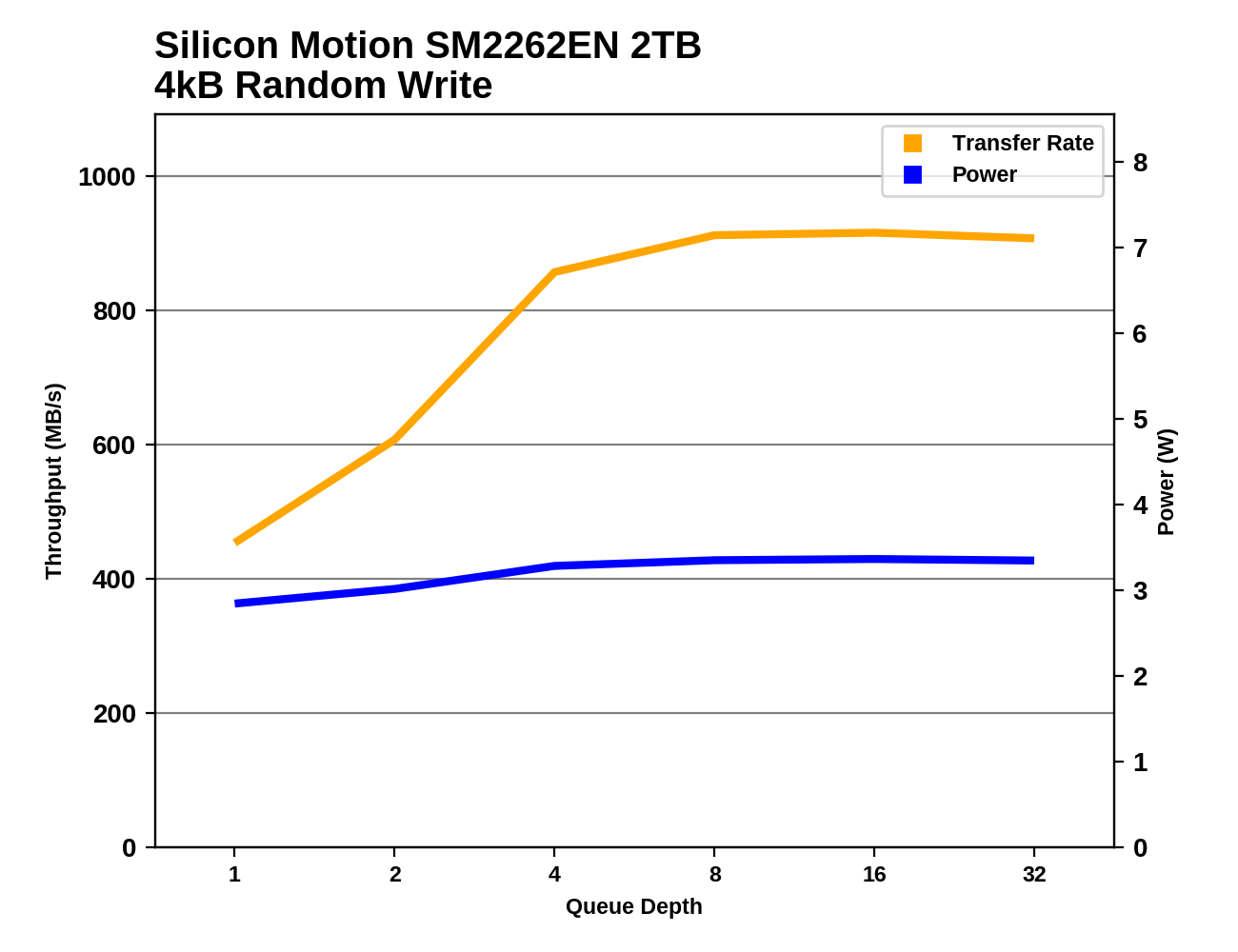The Silicon Motion SM2262EN SSD Controller Preview: Good And Bad Amplified
by Billy Tallis on August 1, 2018 11:45 AM ESTRandom Read Performance
Our first test of random read performance uses very short bursts of operations issued one at a time with no queuing. The drives are given enough idle time between bursts to yield an overall duty cycle of 20%, so thermal throttling is impossible. Each burst consists of a total of 32MB of 4kB random reads, from a 16GB span of the disk. The total data read is 1GB.

The 2TB SM2262EN drive expands on Silicon Motion's lead in random read performance with a 10% increase over the 1TB HP EX920's QD1 burst performance.
Our sustained random read performance is similar to the random read test from our 2015 test suite: queue depths from 1 to 32 are tested, and the average performance and power efficiency across QD1, QD2 and QD4 are reported as the primary scores. Each queue depth is tested for one minute or 32GB of data transferred, whichever is shorter. After each queue depth is tested, the drive is given up to one minute to cool off so that the higher queue depths are unlikely to be affected by accumulated heat build-up. The individual read operations are again 4kB, and cover a 64GB span of the drive.

On the sustained random read test, the SM2262EN's standing is even better. Its predecessors were not able to beat the Samsung 970 PRO or MLC drives on the longer random read test, but the -EN does so with ease.
 |
|||||||||
| Power Efficiency in MB/s/W | Average Power in W | ||||||||
The power consumption of the SM2262EN is a bit higher than for the SM2262 drives, which makes it the most power-hungry M.2 drive in this batch. But the performance is high enough that the efficiency score climbs to almost tie the best flash-based SSDs while the older SM2262 drives had quite poor scores here.
 |
|||||||||
The SM2262EN's lead seems to be strongest at low queue depths, which is what's most important for consumer workloads. The Samsung 960 PRO passes the SM2262EN at QD8 and the 970 EVO and WD Black are closing in at higher queue depths. By QD32 the SM2262EN is approaching the throughput of Intel's Optane SSDs.
Random Write Performance
Our test of random write burst performance is structured similarly to the random read burst test, but each burst is only 4MB and the total test length is 128MB. The 4kB random write operations are distributed over a 16GB span of the drive, and the operations are issued one at a time with no queuing.

The SM2262EN takes first place in the burst random write test, showing that it has the fastest SLC write cache. It is 8% faster than the Phison E12 engineering sample we tested and 25-30% faster than the SM2262 drives we have tested.
As with the sustained random read test, our sustained 4kB random write test runs for up to one minute or 32GB per queue depth, covering a 64GB span of the drive and giving the drive up to 1 minute of idle time between queue depths to allow for write caches to be flushed and for the drive to cool down.

On the longer random write test, the SM2262EN hangs on to first place, though with a much narrower lead of about 2% over the WD Black. The test is still short enough to be working only with the SLC write cache for the 2TB SM2262EN drive.
 |
|||||||||
| Power Efficiency in MB/s/W | Average Power in W | ||||||||
The performance boost the SM2262EN brings is enough to boost its efficiency score into the top tier, though it still isn't quite matching the efficiency of the WD Black. In absolute terms, power consumption is actually slightly lower than the 1TB HP EX920.
 |
|||||||||
The SM2262EN has the best random write performance at low queue depths, but by QD4 the other top NVMe SSDs have caught up or slightly surpassed it. At QD8 and higher, performance holds steady and the SLC cache never gets entirely filled during this test.










28 Comments
View All Comments
Billy Tallis - Wednesday, August 1, 2018 - link
The sustained I/O synthetic tests move far too much data for DRAM caching of user data to have much impact. The burst I/O tests could theoretically benefit from using DRAM as a write cache, but it doesn't look like that's the case based on these results, and I don't think Silicon Motion would really want to add such a complication to their firmware.leexgx - Saturday, August 4, 2018 - link
don't think any SSD has used the DRAM as cache (only used for PAGE table) i could speed things up a little but your still limited by the NAND speed any way, Writing directly to NAND makes more senseMikewind Dale - Thursday, August 2, 2018 - link
That drop in performance in the Heavy test, going from empty to full, was horrifying. I'd like to see some additional tests where the drive gets progressively closer to full. At what point does the drive's performance plummet? Is it gradual or sudden?With other drives, it doesn't matter so much. Most of them have approximately (within 10-20%) the same performance when empty or full, so a person using a full drive will still get approximately the same experience no matter how much they use the drive. But the SM2262EN loses about 80%(!!!!) of its performance when full. So it would be important to know how quickly or gradually this loss occurs as the drive fills.
jjj - Thursday, August 2, 2018 - link
Any chance you are going to the Flash Memory Summit? Might be an interesting year.Billy Tallis - Thursday, August 2, 2018 - link
Yep, we'll be at FMS next week. Tuesday is going to be a very busy day.jjj - Thursday, August 2, 2018 - link
Great, looking forward to your reports!Death666Angel - Thursday, August 2, 2018 - link
Considering this thing is still in a beta state, I don't think any further investigation into the full state performance is beneficial to us consumers. But if a SM2262EN SSD hits the shelves and is buyable, then a look into different states of fullness and the corresponding performance will be greatly appreciated. :D Good test and SSD controller so far.DigitalFreak - Thursday, August 2, 2018 - link
I would definitely like to see this with a retail drive.iwod - Thursday, August 2, 2018 - link
So have we reached peak SSD? If even Optane don't give us any user perceived performance, then surely user would choose larger capacity SSD than 3GB/s vs 2GB/s SSD.Right now we need price to drop faster. 500GB PCI-E SSD with 1GB/s + Speed should be under $100.
rpg1966 - Thursday, August 2, 2018 - link
"Silicon Motion's second-generation NVMe SSD controllers have all but taken over the consumer NVMe SSD market. Drives like the HP EX920 and ADATA SX8200 currently offer great performance at prices that are far lower than what Samsung and Western Digital are charging for their flagship products."This (kind of) implies that the controller is the biggest cost element of a drive. Does anyone have a rough breakdown of parts costs for a drive like this, i.e. controller, DRAM, NAND, and the board+ancillaries?